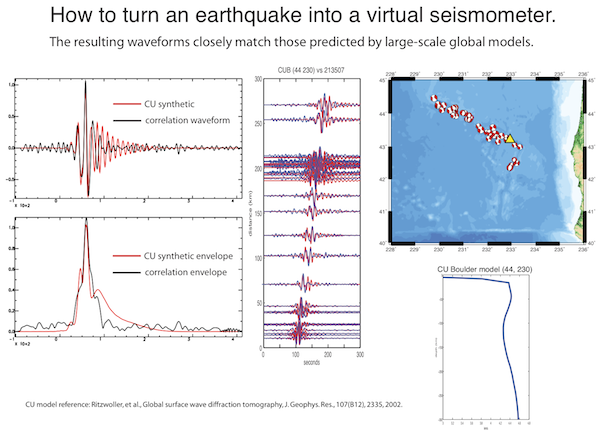2012 IRIS Workshop
Imaging faults using virtual seismometers
Eric Matzel: Lawrence-Livermore National Laboratory
Proof of concept of the Virtual Seismometer Method. The virtual seismogram (black) for one event located on the Blanco Fracture Zone recorded by a "virtual seismometer" (yellow triangle on map) compared with the synthetic seismogram expected for that trace using the CU Boulder 3D Earth model. Center: the same for all the traces in the sequence relative to the reference “virtual seismometer” .

Full-resolution graphics file in original format: 0135.ai
Seismic interferometry has proven to be a powerful method for imaging the Earth's interior. To date, much of the work in seismic interferometry has used ambient noise correlation, which isolates the seismic energy between pairs of seismometers. This has resulted in sharp images of the crust and upper mantle, particularly in areas with dense seismic networks. Curtis et al. (2009) demonstrated that we can reverse the geometry of the problem to focus instead on the energy between pairs of earthquakes. The Virtual Seismometer method (VSM) involves correlating the coda of pairs of events recorded at individual stations and then stacking the results over all stations to obtain an estimate of the Green's function (GF) between the sources. By effectively replacing each earthquake with a "virtual station" recording all the others, VSM isolates the portion of the data that is sensitive to the source region and significantly improves our ability to see into tectonically active features. VSM is proving to be a powerful method for studying individual earthquakes and the source region. Using this technique, we are able to recover the expected GF between pairs of earthquakes, relocate the earthquakes in time and space, measure the source-time function and source magnitude, and finally image the structure along the path between them. Here we show the power of the technique for imaging active faults. First, we apply it to dozens of small and moderate magnitude earthquakes originating along the Blanco Fracture Zone, a 350 km long active transform fault off the coast of Oregon, recorded by stations in Southern California. This demonstrates that VSM can accurately recover the GF between earthquakes even in areas with poor station coverage. Finally, we focus on well located earthquakes and explosions in the Salton Sea geothermal region, illustrating the scalability of the technique to very small magnitude events. Of particular interest are the highest frequencies and smallest magnit
Keywords: interferometry, tomography
